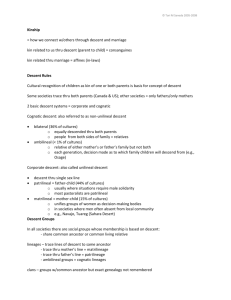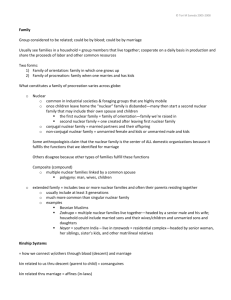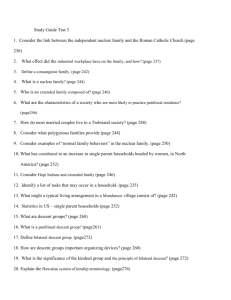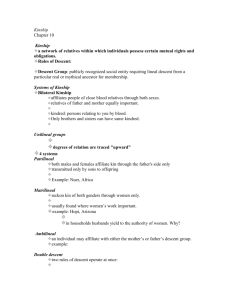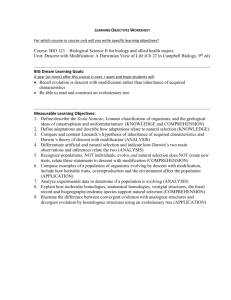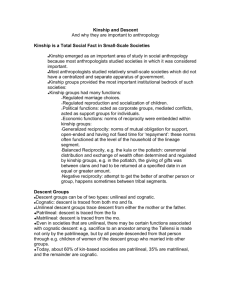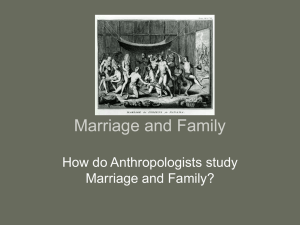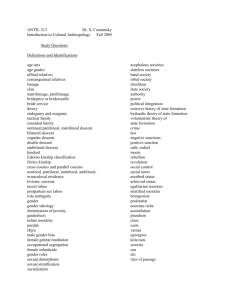Marriage, Family and Kinship
advertisement
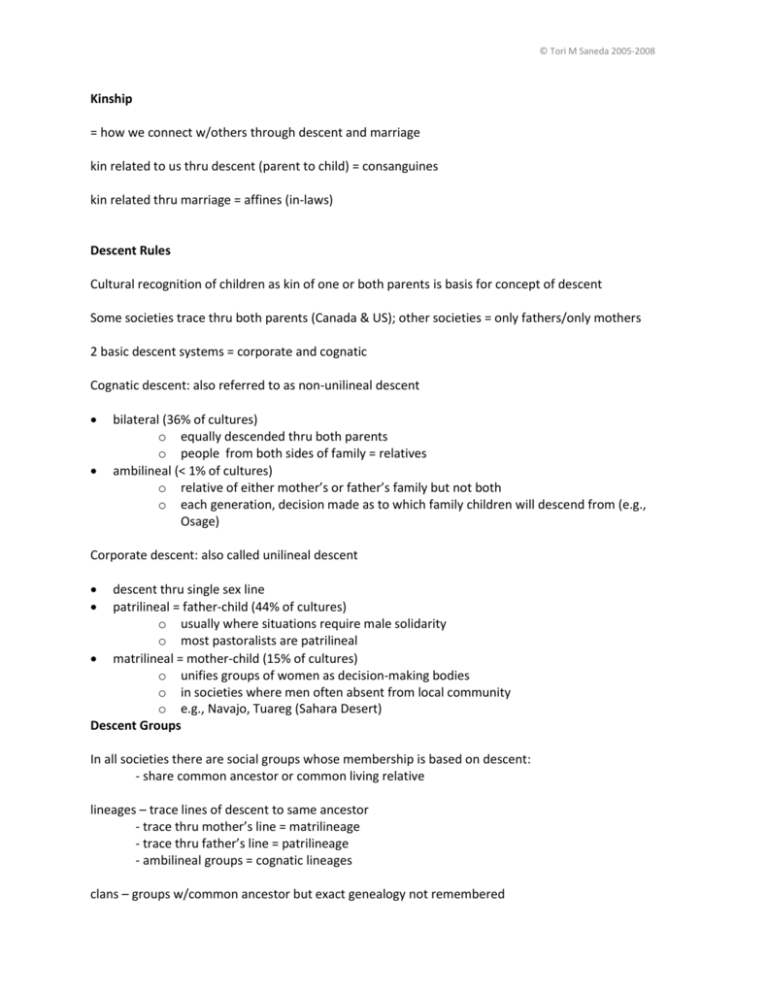
© Tori M Saneda 2005-2008 Kinship = how we connect w/others through descent and marriage kin related to us thru descent (parent to child) = consanguines kin related thru marriage = affines (in-laws) Descent Rules Cultural recognition of children as kin of one or both parents is basis for concept of descent Some societies trace thru both parents (Canada & US); other societies = only fathers/only mothers 2 basic descent systems = corporate and cognatic Cognatic descent: also referred to as non-unilineal descent bilateral (36% of cultures) o equally descended thru both parents o people from both sides of family = relatives ambilineal (< 1% of cultures) o relative of either mother’s or father’s family but not both o each generation, decision made as to which family children will descend from (e.g., Osage) Corporate descent: also called unilineal descent descent thru single sex line patrilineal = father-child (44% of cultures) o usually where situations require male solidarity o most pastoralists are patrilineal matrilineal = mother-child (15% of cultures) o unifies groups of women as decision-making bodies o in societies where men often absent from local community o e.g., Navajo, Tuareg (Sahara Desert) Descent Groups In all societies there are social groups whose membership is based on descent: - share common ancestor or common living relative lineages – trace lines of descent to same ancestor - trace thru mother’s line = matrilineage - trace thru father’s line = patrilineage - ambilineal groups = cognatic lineages clans – groups w/common ancestor but exact genealogy not remembered - ancestor may be so far back that history becomes distorted and ancestor takes on heroic proportions - e.g., native American groups have clans – ancient lineages often just referred to as an animal (wolf, raven) - clans can be huge (large # of people) phratries – groups of clans thought to be related by kinship - may be fictitious kinship, but everyone acts as if kin moieties – one of two descent groups - e.g., Jomon kindred – all relatives on both sides (bilateral descent) - usually see in groups where small family groups more adaptive than large ones and individual mobility high (e.g., industrial societies) - e.g., me/immediate family/aunts, uncles, cousins and their offspring - often fall apart when unifying focus dies - may only get together for funerals, weddings and family reunions Increasing social complexity often leads to bilateral descent and kindred groups (economically independent) Kinship terminology = system we use to identify distinctions among relatives important to our lives - takes into account differences: 1. paternal vs. maternal kin 2. generation 3. differences in relative age 4. sex 5. consanguine vs. affinal ties 6. sex of linking relative = 6 common types: 1. Hawaiian = simplest/has fewest terms - key distinction = generation - cousins seen as brothers/sisters - father, father’s brother and mother’s brother all = father - in simplest sense, kinship terminology = parents, siblings, children - common where nuclear families dependent on other kin; emphasizes cohesion of extended family 2. Eskimo = what US uses - mother, father, sister, brother not used for relative outside of the nuclear family - aunt, uncle, cousin, grandfather/mother used for both sides of family - associated w/societies where nuclear family economically independent (bilateral and kindreds) © Tori M Saneda 2005-2008 3. Omaha = terms come from contrast b/t paternal and maternal relatives - small # of terms to refer to many different kin - patrilineal societies - members of mother’s line distinguished only by sex; e.g., all males from mother’s side = one term; on father’s side, men distinguished by generation 4. Crow = flip side of Omaha - matrilineal societies - father’s line distinguished by sex only 5. Iroquois = different terms for maternal and paternal relatives but don’t merge generations that marry into the lineage - found in groups of unilineal descent (matrilineal) 6. Sudanese = largest terminology - nuclear family terms - terms for both maternal and paternal uncles, aunts, cousins - patrilineal descent most often occurring in North Africa Now, also have instances of FICTIVE kinship – not relatives by descent or marriage - ceremonial relatives - godparents - “brotherhoods” “sisterhoods” - “urban” family

